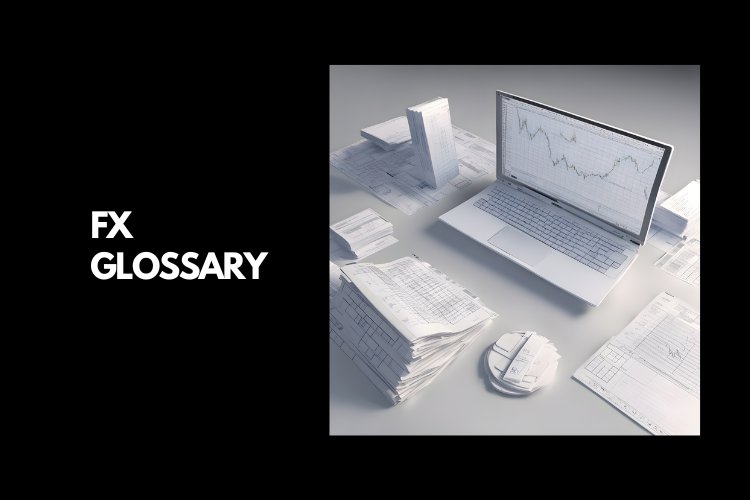Forex Glossary
FX or Forex Glossary

Here is the glossary.
Ask Price: The price at which a trader can buy a currency pair; also known as the "offer" price.
Base Currency: The first currency in a currency pair, which is used as the basis for the exchange rate.
Bear Market: A market characterised by declining prices, indicating a downtrend.
Bid Price: The price at which a trader can sell a currency pair.
Bull Market: A market characterised by rising prices, indicating an uptrend.
Candlestick Chart: A type of chart used in technical analysis that displays price information in candlestick form, showing open, close, high, and low prices.
Currency Pair: The combination of two currencies involved in a Forex trade, e.g., EUR/USD (Euro/US Dollar).
Day trading is a trading strategy where positions are opened and closed within the same trading day.
Exchange Rate: The price of one currency in terms of another, indicating how much one currency is worth compared to another.
Fundamental Analysis: The analysis of economic, political, and financial factors that influence currency prices
Leverage is the use of borrowed capital to increase the size of a trading position, which amplifies both potential profits and losses.
Long Position: A position where a trader buys a currency pair with the expectation that its value will rise.
Lot: A standardised trading size; standard lots are usually 100,000 units of the base currency.
Margin: The amount of money required as collateral to open or maintain a trading position.
Margin Call: A notification from your broker to deposit more funds if your account balance falls below a certain level due to losses.
Market Order: An order to buy or sell a currency pair at the current market price.
Pip (Percentage in Point): The smallest price move that a given exchange rate can make, typically the fourth decimal place for most currency pairs.
Quote Currency: The second currency in a currency pair, which you use to buy or sell the base currency.
Risk/Reward Ratio: The ratio between the potential profit and potential loss in a trade.
Short Position: A position where a trader sells a currency pair with the expectation that its value will fall.
Spread: The difference between the bid and ask prices, representing the broker's profit.
Stop-Loss Order: An order placed to limit potential losses by automatically closing a trade if the market moves against your position.
Take-Profit Order: An order placed to automatically close a trade when a certain profit level is reached.
Technical Analysis: The analysis of historical price and volume data to forecast future price movements
Volatility: The degree of price fluctuation in a currency pair.
Liquidity: the ease with which a currency pair can be bought or sold without significantly affecting its price.
Moving Average: An indicator used to smooth out price data and identify trends.
RSI (Relative Strength Index): An oscillator used to measure the speed and change of price movements.
Liquidity Provider: Financial institutions or banks that facilitate currency trading by offering bid and ask prices.
Scalping is a trading strategy that involves making small, quick profits from minor price fluctuations.
Hedging is a risk management strategy where a trader opens a position to offset potential losses in another position.
Pipette: A fractional pip, often used for more precise price quoting.
Swap or Rollover: The interest paid or earned for holding a currency position overnight.
ECN (Electronic Communication Network): A type of Forex broker that provides direct access to interbank liquidity.
Slippage is the difference between the expected price of a trade and the actual executed price.
FOMC (Federal Open Market Committee): The policy-making body of the U.S. Federal Reserve responsible for setting interest rates
Bid-Ask Spread: The difference between the highest price a buyer is willing to pay (bid) and the lowest price a seller is willing to accept (ask).
MACD (moving average convergence divergence): an oscillator used to identify potential trends and trend reversals.
Support and Resistance: Key price levels at which a currency pair tends to find buying or selling interest
Order Types: Various types of orders, including limit orders, stop orders, and market orders, are used to execute trades.
Pivot Point: A technical indicator used to identify potential price reversals and support or resistance levels.
Volatility Index (VIX): A measure of market volatility and investor sentiment
Central Bank: The authority responsible for controlling a country's money supply and monetary policy.
Scalping is a trading strategy that aims to profit from very small price movements by making numerous quick trades.
Risk Management: Strategies and Techniques to Minimise Potential Losses in Trading
Whipsaw: A situation where the market quickly reverses direction, causing losses for traders who were positioned in the opposite direction.
Drawdown: The peak-to-trough decline during a specific trading period, often used to measure the risk of a trading strategy.
Arbitrage is the simultaneous purchase and sale of the same or similar assets to profit from price differences in different markets.
Margin Level: A percentage representing the equity in a trader's account relative to the required margin for open positions.
Quantitative Easing: A central bank policy of increasing the money supply by purchasing government securities or other assets
This glossary covers a wide range of terms related to forex and forex trading. Remember that forex trading involves significant risk, and it's essential to thoroughly understand these terms and concepts before participating in the market.
Okay, Now check this out…
TradeFxP Features
If you choose to be a self-employed retail trader, here are a few things we offer:
- The best trading Platform
- No Requotes
- Lowest Spreads
- High level liquidity
- Interbank connectivity
- Pure STP/DMA/ECN
- Free signals
- Best support
- Crypto Wallet and withdrawals / Deposits (USDT)
- Robust CRM
- TradeFxP wallet
- Once click withdrawal
- Multiple payment options
- Local offices to walk in
- Free VPS
- Free Video Chat / Virtual Meetings
- And many more…
If you choose to be a part of our managed account programme:
- All of the above +
- High level risk management
- Capital protection
- Only 30% of the capital used
- Negative balance protection
- Our fee is from the profits only
- Monthly profit withdrawal
- Wallet system – Use it like Phonepe, or google pay
- Crypto wallet and withdrawals / Deposits (USDT)
- Live monitoring
- MyFxbook Live monitoring
- Copy Trading
- And many more…
Optional: If you do not withdraw your profits for 2 months, our system will use those profits to trade and will keep your 100% capital safe and secure for margin purposes. This is optional, and if you choose not to be a part of it, you can withdraw your profits from the first month itself.
If you choose to be a part of us as an introducing broker (IB) or channel partner,
- Industry best Rebates
- Local Office support
- Staff support
- Marketing support
- Marketing materials
- And many more…
Having said that….
You can join our Forex Managed Account programme and earn 1-2% profits daily. See for yourself by clicking the below link.
Have a great journey, and may you catch some big waves on your way to prosperity!
To see Ai Forex Trading for real, use these credentials.
- Low-risk strategy:
- Mt4: 112018
- Pw: Allah@101
- Server: tradefxp live,
1. To read why you should be with us, click here.
2. To open an account, click here.
3. To see our regulation certificate, click here.
4. To see our news with the IFMRRC, click here.
5. For claims, click here.
6. For the main site, click here.
7. For blogs and articles, click here.
8. Main Website: www.TradeFxP.com



 admin
admin 










